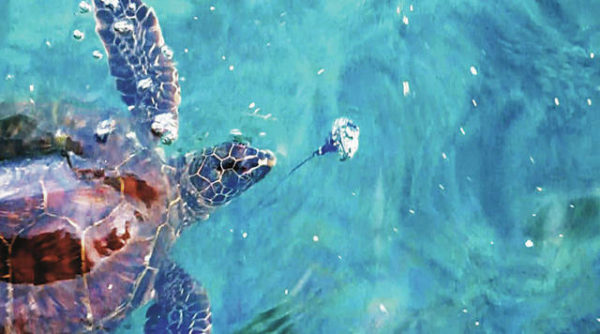Published in the Ocean Watch column, Honolulu Star-Advertiser © Susan Scott
January 13, 2018
- Green turtles have become abundant on Midway Atoll, choosing to bask in particular on Midway’s Sand Island. An immature green turtle on Midway prepares to eat a Portuguese man-of-war. Courtesy Hope Ronco.
I missed going to Midway this year, but because two friends had flown there early, and they’re back now, I get to enjoy tales of the atoll.

Midway is famous for hosting the largest albatross colony in the world (1 million to 2 million individuals), but it’s also become a place to admire sea turtles. My friends are still marveling over the sight of a green turtle gobbling up a raft of Portuguese men-of-war.
During my first visits to Midway in the 1980s, I didn’t see any turtles. But decades of protection have helped Hawaii’s greens thrive, and as their numbers increase, the turtles are branching out. For reasons known only to the turtles, some routinely swim to Midway’s Sand Island to bask on one particular beach.
On Oahu’s North Shore, seeing nine or 10 turtles dozing on the beach is a good day. Midway’s turtles, though, have made basking practically a team sport.
During my albatross work two years ago, I counted 38 adult turtles sunbathing on that beach, some so close together that their flippers draped over their neighbors’ broad backs. Now this beach sometimes hosts more than 50 individuals.
A few turtles lay eggs at Midway, but the atoll is not yet a significant nesting spot for Hawaii’s greens. Because most turtles return to their hatching place to mate and lay eggs, and green turtles don’t reach sexual maturity until they’re 20-plus years old, it takes decades to establish new breeding colonies.
Limited nesting beaches is one reason Hawaii’s green turtles are still listed as a threatened species. More than 90 percent lay their eggs at French Frigate Shoals, about 500 miles northwest of Oahu and 700 miles southeast of Midway.
Two weeks ago in Midway’s harbor, my friends saw an immature turtle, about the size of a dinner tray, eating trapped Portuguese men-of-war. This was a wind-created pupu platter for the turtle, which took the blue floats, one at a time, into its mouth.
Seeing the creatures’ tentacles dragging over the corners of the turtle’s mouth was cringe-worthy for the human onlookers, but the nasty men-of-war’s stinging cells didn’t seem to hurt the turtles’ skin or tongue.
As my friends and I strolled through Haleiwa Beach Park last week, we came across a friendly and informative turtle and seal guardian, Niko Lopez, from a nonprofit called Hawaii Marine Animal Response, or HMAR.
We learned that volunteers with this citizen science group work with federal and state agencies to patrol, teach, protect and rescue Hawaii’s turtles, seals, whales and dolphins on Oahu and Molokai. HMAR volunteers in 2016 were out 3,700 times, engaging about 56,000 members of the public.
Report turtle or seal injuries or abuse to HMAR at 888-256-9840. For more information or to volunteer with the group, see h-mar.org.
Portuguese men-of-war are remarkable animals in their own right, but they do pack a punch to human skin. Nice to know that our honu are helping keep the rascals in check.